
Sydney Rows
A Centennial History of the Sydney Rowing Club, 1970, by A L May
Table of Contents
Chapters
- Preliminaries: before 1870
- Foundations: 1870-1880
- New Clubs: 1880-1890
- The Amateur Question: 1890-1900
- Sydney on Top: 1900-1910
- Henley and War: 1910-1920
- Pearce and Mosman: 1920-1930
- Financial Problems: 1930-1940
- War and Wood: 1940-1950
- Strength and Stability: 1950-1960
- On Top Again: 1960-1970
Appendices
11. On Top Again: 1960-1970
Chapter Eleven page 1 2 3 4 5 6
SRC had the best record of any club on the river during the new decade and enjoyed the satisfaction of seeing an unprecedented number of its members win Olympic representation. The premiership was won five times, with three seconds and two thirds also recorded. The junior title was won six times, with two seconds and one third also notched. On three occasions - 1962/63, 1963/64 and 1968/ 69, both pennants were won in the same year.
Membership and finances remained strong, while further significant expansion and improvement of the club's premises was carried out. For Australian rowing overall, there were no less than eight overseas tours, while the decade ended on a high note with the best Olympic rowing performance ever being recorded at the 1968 Mexico City Games.

John Magner and Stewart Derwin on the ergometres
Substantial improvements to the club house and boatshed were effected during the decade while, at its close, plans for major extensions were under active consideration. In 1960/61, the major work undertaken was the top dressing and lawn planting of the reclaimed foreshore, while the patio at the southwestern side of the clubhouse was enclosed.
The following year, the verandah of the boat house was extended and enclosed with glass, while a glazed observation room was built above the verandah for the use of commentators and officials during regattas. A weather vane, donated by Tom Nickson, was mounted on the flag pole above this point. In the club house, a heating system, an acoustic ceiling in the bar area, new kitchen equipment, a new trophy cabinet and an indoor wall garden over the band rostrum were added.

The property 1969
The 1963/64 season saw completion of separate housing for the speed boats, a flat concrete topped building at the northern end of the property. Major alterations and additions to the club house itself were carried out in 1965/66, at a cost of some £14,000. Following plans drawn up by Miller and Farley, architects, the bar was relocated and modernised and the lounge area much improved through attractive carpeting and new tables and chairs.
In 1966/67 a third bay was added to the boatshed to provide more room for boats and oars with a sun deck comprising the top of the extended area. The parking area had long presented problems through soil being washed away by rain and rutting resulting and, also in 1966/67, proper draining and sealing, along - with illumination at night, was carried out.
Planning for major extensions, including dining room, gymnasium, and area for junior members, also commenced, initially aimed at completion before 1970, and this exercised the committee's attention during the succeeding years. Contributing to the deliberations were the drawings and advice of Dick Newton, Frank McLeod, Warren Firkin, Graham Gibson and Servaas Van Breda. Some minor work took place: repairs to the roof, construction of a new vice-captain's office on the verandah of the boatshed, and the glassing in of the club house verandah on the northern side. (The club's old and distinguished pine tree, planted, it is believed, by the sculler Dick Green, required the services of a tree doctor in 1966 and, fortunately, triumphed over its difficulties.)
An unprecedented number of new racing craft were purchased during the decade, including a number of boats of a new type altogether. Five new eights were bought,- fourteen new fours, six pair oars/double sculls, and a new single scull, apart from two new speedboats and two ergometers. At the end of 1969, the fleet had grown to a total of 28 boats. The new eights were the George Parlby (1961/62), the Charlie Stewart (1963/64), the Frank McLeod (1964/65), the Ossie Rosevear (1967/68) and the Eric Perry (1969/70).
The Associates, the Keary and the Meares were all sold while the Stewart was used for four years only. The club had two best and best fours at the start of the decade but, by the end of 1969, there were five best and best coxed fours and three convertible coxed/coxless fours. The five coxed fours were the Q.L. Deloitte III, purchased in 1958/59; the Norman Grounds, purchased in 1963/64; the Sydney, purchased in 1964/65, initially for the use of the Australian coxed four at the Tokyo Olympics; the Phil Cayzer, purchased in 1966/67 from Stampfli of Switzerland and initially used by the Australian four at the world rowing championships in Yugoslavia; and The Carmodys, purchased early in the 1969/70 season.
The old Deloitte was sold in 1963/64, while the Ladies' Auxiliary, bought in 1961/62, was sold in 1966/67. A best and best coxless four, the Bert and Jack Goulding, was added in 1961/62, but was sold in 1968/69, by which time the era of the "convertible", sectional, coxed/ coxless four was well at hand. Two were purchased was purchased in 1967/68 - the Howard Holden and the Geoff Knight - while a third, the Carl Cameron, was added in 1968/69. Regulation fours were not overlooked. Of the six in the fleet at the start of the decade, all but the Rosevear were replaced, the new craft being the Associates II (1961/62), the Bill Andrews (1963/64), the T.C. Nickson II and the Alf. Duval Snr. (1964/65), and the Ray Green (1968/69).
A number of small boats were also purchased. The Geoff May, a convertible pair-oar/double scull, in 1960/61 but, following an accident during transportation, it was replaced in 1965/ 66 by a coxless pair bearing the same name. The E. H. Ireland, a double scull, and the Harry Clare, a coxed pair, were purchased in 1963/64 and a coxed/coxless pair, the George Carlson, in 1967/68.
A further new type of boat, a convertible double scull/coxed pair/coxless pair, named the Jack Darby, was purchased in 1968/69. The first racing scull ever owned by the club for the use of members, the Gordon Clubb, was purchased in 1966/67. A second-hand scull was also purchased in that year but it lasted little over a season. Although little used, the five scull was retained throughout the decade. The number of gladstone skiffs remained unchanged at three at the end of the decade, while the number of tub pairs fell to two. A second and smaller speedboat-an aluminium-hulled craft with an 18 h.p. motor-was bought during the 1962/63 season. A third speedboat, of a similar type, was purchased in 1967/68, while replacement of motors was made on occasion, as necessary.
After considerable investigation, two ergometers were purchased from E. Curtain Pty. Ltd. in 1961 at a cost of ₤550 each while, in 1967, the club bought a second-hand utility for boat-towing and other duties. With the exception of the Stampfi (built boat, all craft were ordered from the Sydney boat-building firms of George Towns and Sons and Green's Racing Boats (which, in 1962, became Sargent and Burton). Some oars were also purchased from Howard Croker. The bulk of repair work was undertaken by the expert craftsmen of these. firms.
Membership of the club was well over 1,000 by 1970. Up to 1965, however, the level remained at about 750. After the revision of the club's rules in September, 1962, a further reclassification of membership took place, with the former two classes of associates - rowing and social-being altered to simply associate members (those who had been active members of a rowing club for two years) and social members. All existing associate members, however, rowing or social, were deemed to be associates under the new rules. (The 1965 annual meeting added a further qualification: that the number of social members could not exceed 25 per cent of the total of active, life and associate members.) The number of social members grew rapidly - from 55 in March, 1964 to 225 in March, 1969 - and this was largely responsible for total membership topping the 1,000 mark by March, 1968 and reaching 1,077 by March, 1969. By the latter year, the number of life members had increased to 118, the number of "active" members to 327 (although this included many members who no longer took part in rowing activities), and the number of "associates" to 407.
Draught beer first became available at the Branch in 1935, the favoured brew being Resch's until 1961 when Tooheys was also placed "on tap".
The club continued to prosper financially. Reflecting the higher membership figures, the extended and improved premises, and the heightened social activities, bar sales, which averaged around $50,000 a year in the first few years of the decade, were close to $90,000 a year in the later years. Profits on the bar were $8,650 in 1968/69, their highest level of the decade.
Income from subscriptions also rose strongly, from $2,800 in 1960/61 to $6,400 in 1968/69. Once again, however, income from the club's poker machines - thirteen in number in the later years - provided the major part of all earnings. Income from "sundry entertainments" averaged around $30,000 in the first half of the decade, reached a peak of $53,750 in 1966/67 and declined to $45,400 in 1968/69. Taxes on poker machine receipts cut heavily, however, into this source of income. The overall surplus on operations was $18,000 in 1960/61 but, with substantially higher overheads, had fallen to under $5,000 in 1968/69.
The cost of boat maintenance was up to almost $4,000 by the end of the decade and that of the buildings and grounds to over $10,000. Training and regatta costs absorbed over $5,000. The club's assets were valued at $168,800 as at 31 March, 1969, more than double the level at the beginning of the decade. The club house and land were valued at $77,300 and the boathouse and pontoon at $8,100. A major item, of course, was the fleet, valued at $26,400 compared with only $10,300 in March, 1960 and despite the writing off in depreciation of $16,600 during the nine-year period. Furniture and machines were valued at $22,600, while investments and funds set aside into a "building fund" totalled over $20,000. Liabilities consisted solely of normal business creditors, giving the club a substantial borrowing capacity.
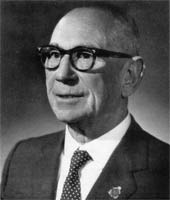
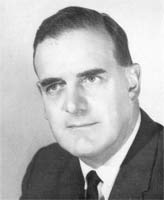
F T D Meares and G E Parlby
Sydney's seventh president was elected during the decade. After ten years in the position, Fred Meares stepped down at the end of 1963/64. As the annual report noted, "his wise counsel and keen interest in Club affairs have been an invaluable help to the Club and all the Committees that have had the honour to be associated with him".
His successor was George Parlby, who was certainly well-versed already in the operations and history of the club. By the end of the decade, Parlby had already run up six years as president, marked by his active participation in actual rowing, in committee meetings, and in all other phases of club life.
The number of vice-presidents stood at 17 at the end of the decade. Nine of this number, Messrs. Bradley, Cater, Crebbin, Foskett, Jack and Bert Goulding, Holden, McLeod and Rosevear, had been vice-presidents ten years before, while Meares had swapped places with Parlby. The seven "new boys" were George Carlson, Frank Hidden, Geoff May, Jack Darby, Joe Gould, Ernie Ireland and Ernie Chapman. Following the decision of the 1960 annual meeting, two of the vice-presidents were elected senior vice-presidents each year and attended committee meetings. Ossie Rosevear was elected to this post in each of the ten years, his colleagues being Holden (three times), Parlby (twice), Hidden (twice) and Darby, May and Chapman (once each).
Sir Eric Woodward continued to extend his patronage to the club and, when Sir Roden Cutler became Governor in 1965/66, he did similarly. By 1969/ 70, the club had enjoyed patronage by the State Governor for 51 years consecutively and for some 82 years of its entire 100 years existence.
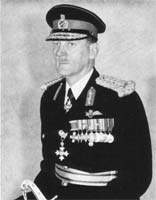

Sir Eric Woodward and Sir Roden Cutler
Amongst the outstanding members passing on during the decade were the following: Arthur Cashman, Cliff Lambert, Keith Corden, Tom Nickson, Owen Hogg, Charlie Stewart, Roger Fitzhardinge, Gig Smedley, Rex Rabett, Peter Darragh, Roy Barker, Bill McMahon, Albert Wood, Bill Dixon and Sid Rafter.
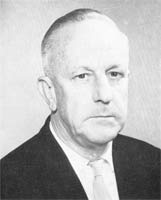

Charlie Stewart and Harry Clare
Four captains led the club during the ten-year period. Jack Goulding was captain for the first three years, Jack Darby in 1963/64, and Geoff Knight in both 1964/65 and 1965/66. Harry Clare, who rejoined the committee in 1963/64, was elected captain in 1966/67 and held the post till the end of the decade.
Six keen members took on the duties of vice-captain during the period: John Magner (three years), Carl Cameron, Stewart Derwin, Ray Green, Keith Jameson and Stuart Agnew. For most of the period, the vice-captain was assisted by a boathouse committee while, in 1969, the appointment of a "boat master" was approved by the annual meeting.
Kevin Wearne ably filled the position of honorary secretary from 1960/61 to 1962/63 and Graeme Bell held the post in 1963/64. hereafter, the position disappeared, a salaried "Secretary/ Manager" taking over these and other duties. The position of honorary assistant secretary continued, however, being filled by Charlie Stewart (three years), Doug Donoghue (two), Howard Holden (two), Carl Cameron (two) and Selwyn Owen (one).
Jack Creaser retired from the position of honorary treasurer in 1965/66 after a nine-year stint and was succeeded by Alan May. Mid-way through 1968/ 69, he, in turn, was succeeded by Eric Perry. The position of assistant treasurer was filled by no less than nine persons during the decade. Long-serving committeemen included Alf Duval snr. (his term broken by an unfortunate accident), Alan Shedden, Jim Goulding and Phil Cayzer.
Running the club efficiently required the assistance of many other persons. In 1967/68, after 31 years in the position, Fred Pike retired as a club auditor, being succeeded by Jack Creaser. The remaining auditor, Geoff May (who had refrained from acting in the position while his son was treasurer), stayed on and had been an auditor for 33 years by the end of the decade. Fred Meares and Donald Glasson continued to act as trustees, bringing their term of service in this role to almost a quarter of a century. Glasson also continued to serve the club in the role of honorary solicitor as well.
Special reference would appear to be due to Howard Holden, probably the club's most versatile office-bearer ever. In the 26 years from 1944/45 to 1969/70, he served the club for ten as treasurer, three as assistant treasurer, one as secretary, two as assistant secretary, ten as vice-president (including three as senior vice-president), portion of one as vice-captain and four as committee man. In addition, he undertook a wide range of coaching duties, with outstanding success.
Publicity for the club's activities and for rowing in general was well catered for by George Carlson, Harry Clare and Alan Callaway during the ten-year period. Contacts were made and developed with newspapers and radio and television stations while, in 1963/64, Harry Clare commenced issuing Easy All, an occasional newsletter of items of interest to members of the club. As the Sydney Waratah Festival developed in the middle of the decade, the club participated through floats in the procession and, from 1965, through the organization of a special regatta on the club course.
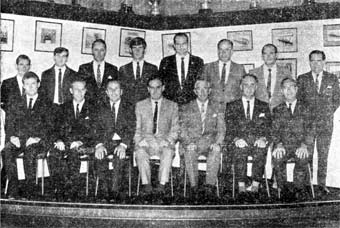
1969-70 Committee
Back row (left to right): Kevin Hollingworth, Ray Green, Doug Donoghue, Bob Tagg, Alf Duval, Phil Cayzer, Don Sutherland, Fred Henwood, (Secretary/Manager). Front row: Keith Jameson, Eric Perry, Harry Clare, George Parlby, Ossie Rosevear, Ernie Chapman, Howard Holden. Absent: S Agnew.
The salaried position of club administrator was filled by Harold Smith until a special general meeting in December, 1963 amended the club's constitution to allow the appointment of a full-time secretary. Les Newton was employed in the position on a trial basis and, in April, 1964, Noel McCall was appointed. In January, 1965, Fred Henwood, a member of the club to this time, was appointed Secretary/Manager. He held the post until May, 1966, being succeeded soon after by the bar manager, John Bosden. Henwood returned to the club in September, 1967, to resume the post. Permanent bar and cleaning staff were employed during the decade, long-term employees including Ross Holley, Fred Fontaine and John McDonald. Paid casuals were employed behind the bar on dance nights and for other occasions as necessary and snack bar facilities (subsidised by the club) were also operated on Saturdays and Sundays. The services of a car attendant on weekend evenings were engaged from September, 1966. Arthur Chadwick retired as an employee of the club in 1966/67 but, together with his wife Plassy, stayed on thereafter as caretaker in the remaining portion of the original Red House.
